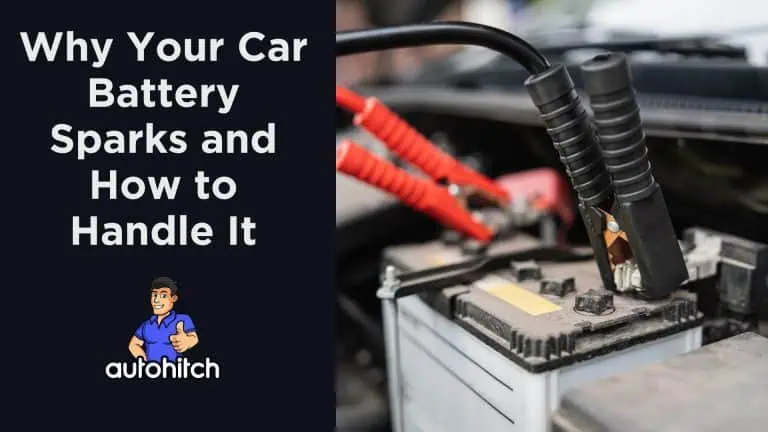You just tried to connect your car battery to the positive terminal, and BANG- You see/hear a massive spark.
Don’t worry; seeing sparks when connecting a car battery is perfectly normal, especially in modern vehicles with all of the added technology and electrical equipment.
I created the article below based on my years of experience as a licensed car dealer in Florida, where we had to change batteries in used cars almost daily.
I’ll explain how to minimize sparks, what causes battery sparking, how to handle it safely, and troubleshooting issues if your car won’t start after.
Table of Contents
Related Article To Read:
- What Size Wrench For Car Battery
- How Often Should You Change A Car Battery
- How To Buy A Car Battery at Costco
6 Ways to Minimize Sparking
While a small spark is unavoidable, you can reduce sparking risk:
- Turn vehicle electronics OFF before connecting the battery to reduce the initial power draw
- Check for dome lights or other circuits drawing power unintentionally
- Connect the positive terminal first, followed by the negative
- Use insulated tools to reduce accidental shorts
- Pre-charge headlights briefly before connecting the battery to minimize inrush current
- Have the battery/electrical system inspected annually to avoid issues
What Causes a Car Battery to Spark?
Sparking occurs due to an electric arc forming from the potential difference between the battery’s positive terminal and the cable/connector. The main culprits are:
- Inrush Current: Modern cars have electronics that draw power even when off. Reconnecting the battery causes a power surge that makes electrons jump.
- Electric Potential: There is always a slight difference in electric potential energy between the disconnected battery and other components. When reconnected, the energy equalizes through sparks.
- Weak Battery: A discharged or failing battery tries to draw more power when reconnected, increasing sparking.
Normal vs Excessive Sparking
Normal: A small, brief spark upon connection is expected, and sparks on the positive terminal are more common.
Excessive: Large, sustained sparks with smoke/heat indicate serious issues like:
- Short circuit
- Loose battery terminals
- Incorrect cable placement
- Damaged battery/cables
Safety First When Connecting Cables
Battery mishandling can cause shocks or explosions. Follow these precautions:
- Switch electronics OFF before disconnecting/reconnecting the battery
- Avoid leaning over the battery
- Wear insulated gloves and eye protection
- Connect positive cable first, negative last
- Use insulated tools
- Work in a ventilated area
Battery Sparked Now Car Won’t Start
When a car battery sparks during connection and fails to start the vehicle, it often indicates an issue within the vehicle’s electrical system.
Common Causes for Non-Starting After Sparking
- Loose or Corroded Battery Terminals
- A loose connection can cause sparking and may not provide enough power to start the car.
- Corrosion at the terminals can also inhibit electrical flow, necessitating a thorough cleaning or tightening of the connections.
- Faulty Starter Motor
- The starter motor is crucial for initiating the engine’s operation. If it’s faulty, even with a good battery connection, the car won’t start.
- Blown Fuses or Relays
- A spark can sometimes cause a surge that blows a fuse or relay, particularly those related to the starter circuit or fuel pump. This would prevent the car from starting as these components are essential for engine operation.
- Bad Alternator
- While an alternator issue wouldn’t typically prevent a car from starting immediately after a spark, if the alternator fails to charge the battery adequately after the initial start, it can lead to a situation where the car won’t start on subsequent attempts.
- Electrical Short Circuits
- A spark can indicate a short circuit within the vehicle’s electrical system. This could be due to damaged wiring or components, leading to a drain on the battery or damage to critical starting components.
Troubleshooting Steps When Car Won’t Start After Battery Spark
- Inspect and Clean Battery Terminals
- Ensure the battery terminals are clean and tightly secured. Corrosion can be cleaned with a mixture of baking soda and water.
- Check the Starter and Its Relay
- Listen for the click sound when attempting to start the car. No sound or a weak sound could indicate a starter or relay issue. Testing these components may require professional tools or assistance.
- Examine Fuses and Relays
- Locate the fuse box and check for any blown fuses or damaged relays, especially those related to the starter system and fuel pump. Replace any that are faulty.
- Evaluate the Alternator
- If the car started initially but fails to do so later, the alternator might not be charging the battery correctly. Testing the alternator’s output with a multimeter can diagnose this issue.
- Seek Professional Help
- If the above steps do not resolve the issue, or if you suspect a more complex electrical problem, such as a short circuit, it’s advisable to consult with a professional mechanic. They can perform a comprehensive diagnostic to identify and fix the problem.
Replacing damaged components as needed often solves the problem.
Key Takeaways
- Minor sparking when reconnecting a car battery is expected and harmless. Excessive sparking indicates problems needing attention.
- Take essential precautions like switching electronics off, wearing insulated gloves, and avoiding working over the battery.
- Steps like using insulated tools, turning lights on briefly before disconnecting the battery, and having annual electrical inspections can minimize sparking.
- If the car won’t start after sparking, methodically assess battery terminals, starter, fuses, alternator, and potential short circuits.
- Seeking assistance from a certified mechanic is advisable if you’re uncomfortable troubleshooting electrical issues yourself.
With proper handling, the small sparks seen when jump-starting or replacing a car battery are no cause for concern. But be alert to signs of deeper issues, exercise due safety, and don’t hesitate to consult experts when needed.



